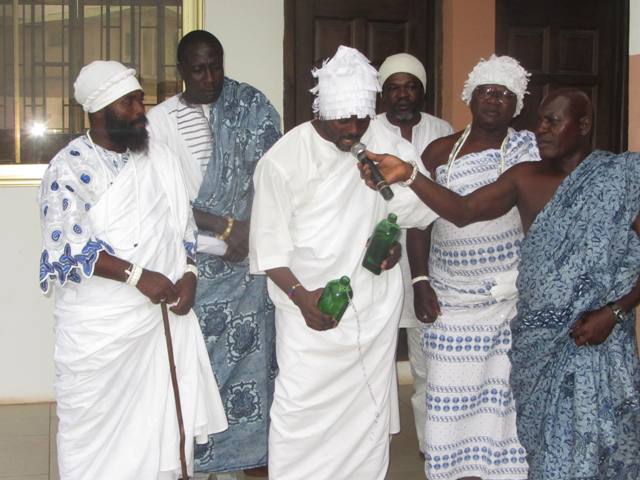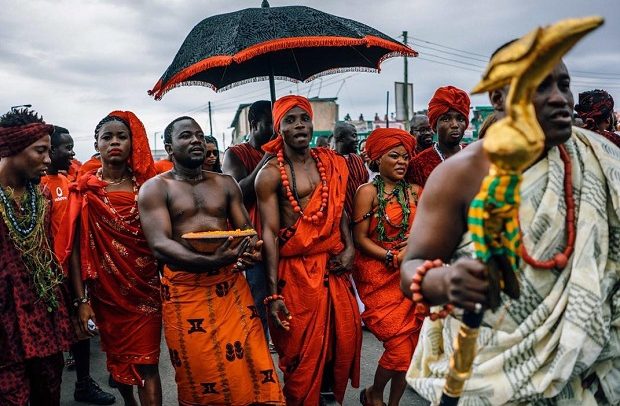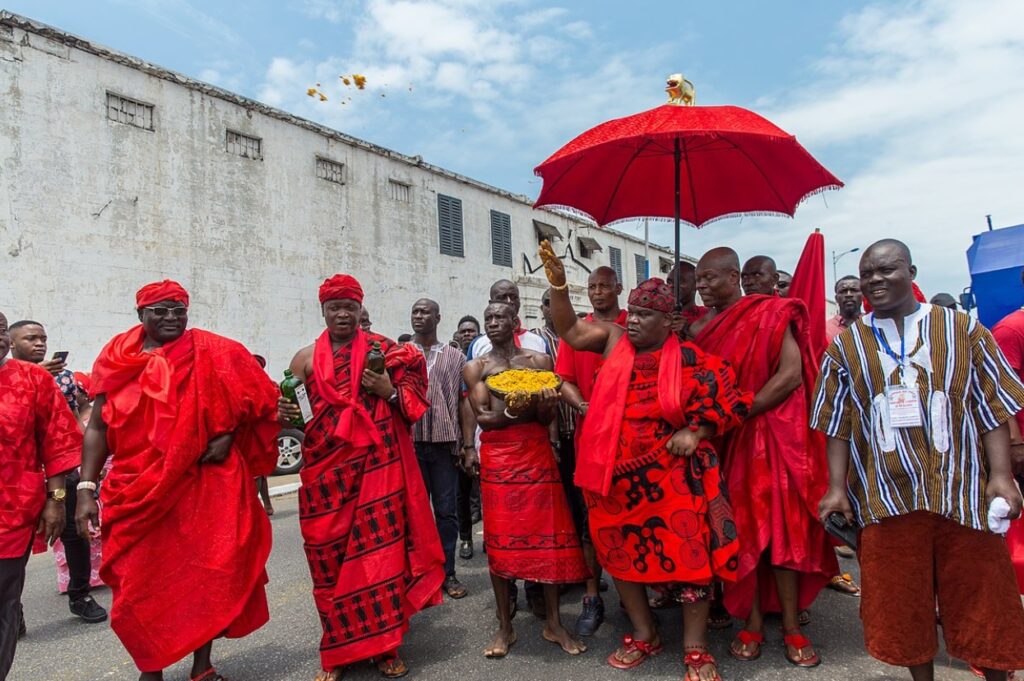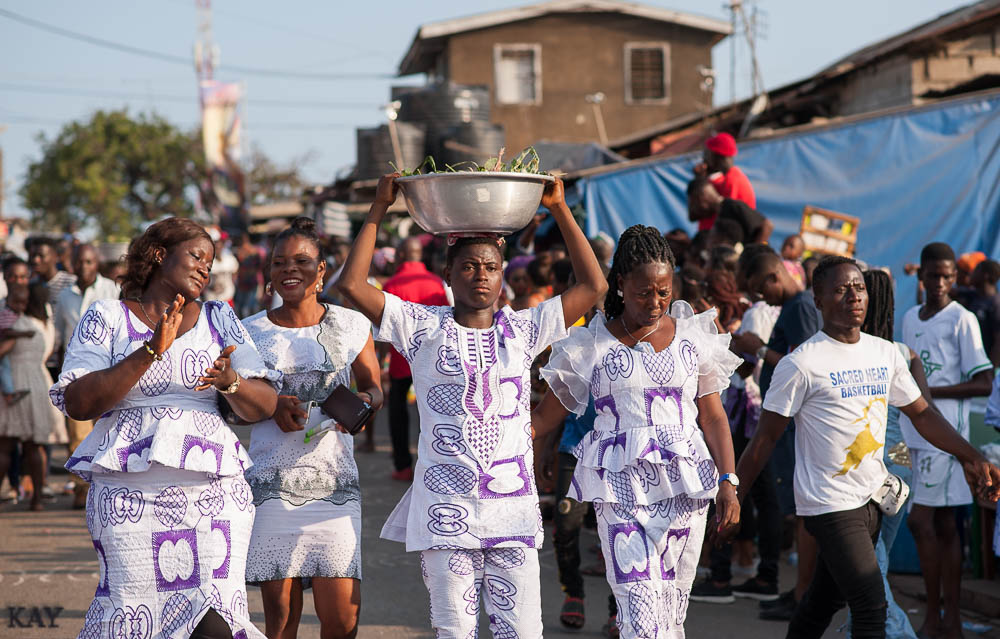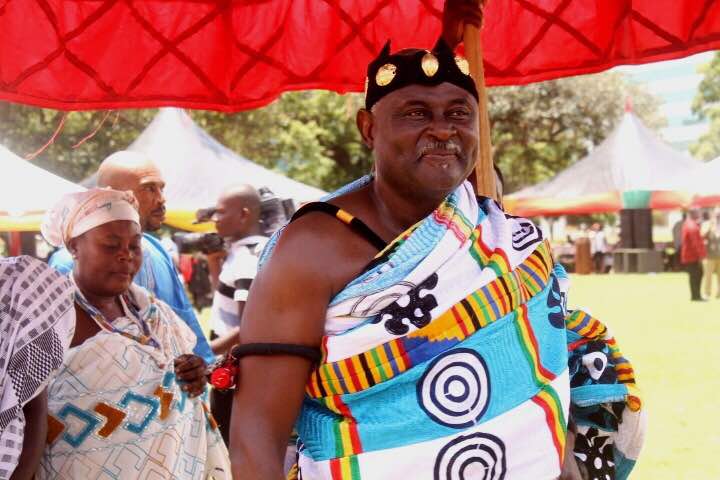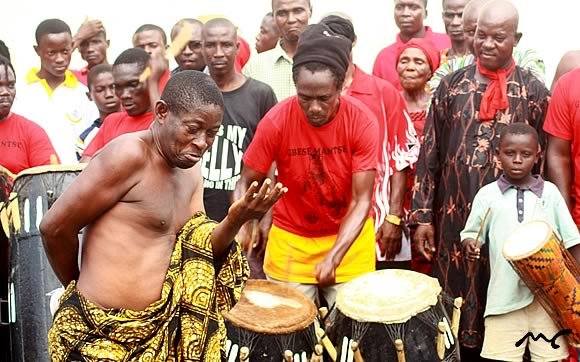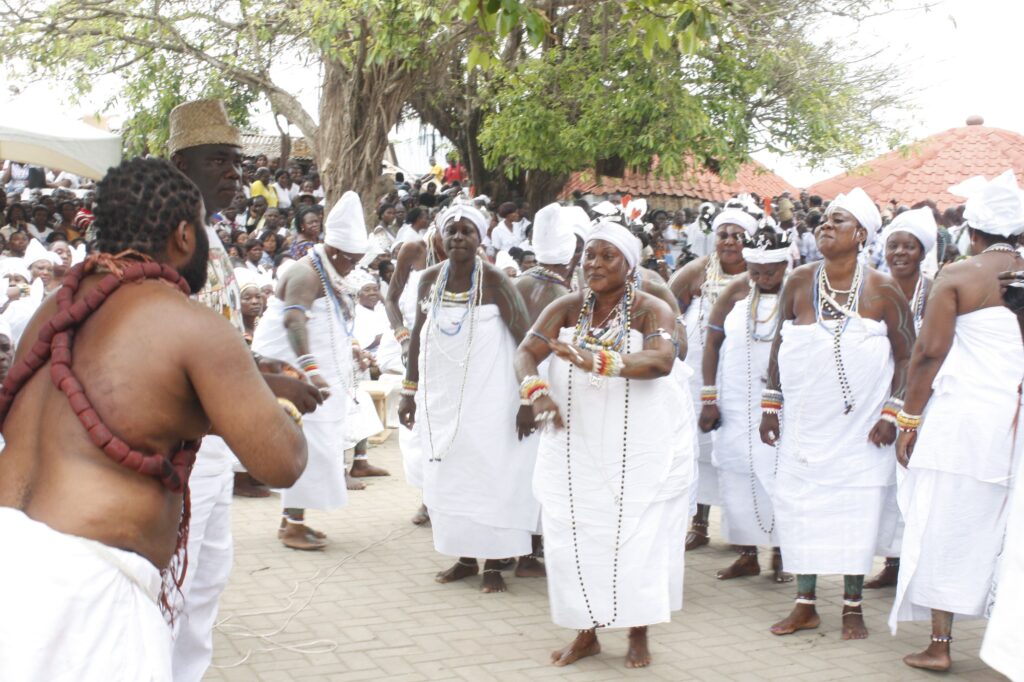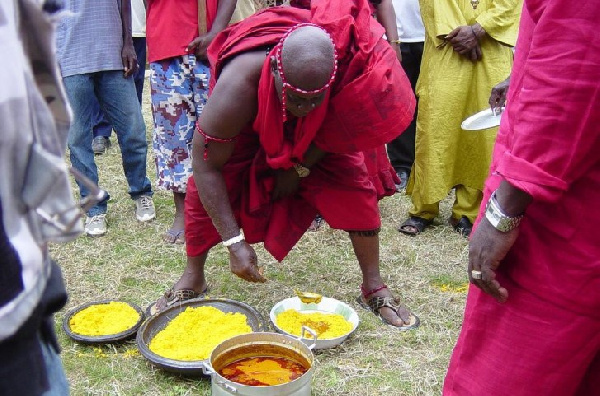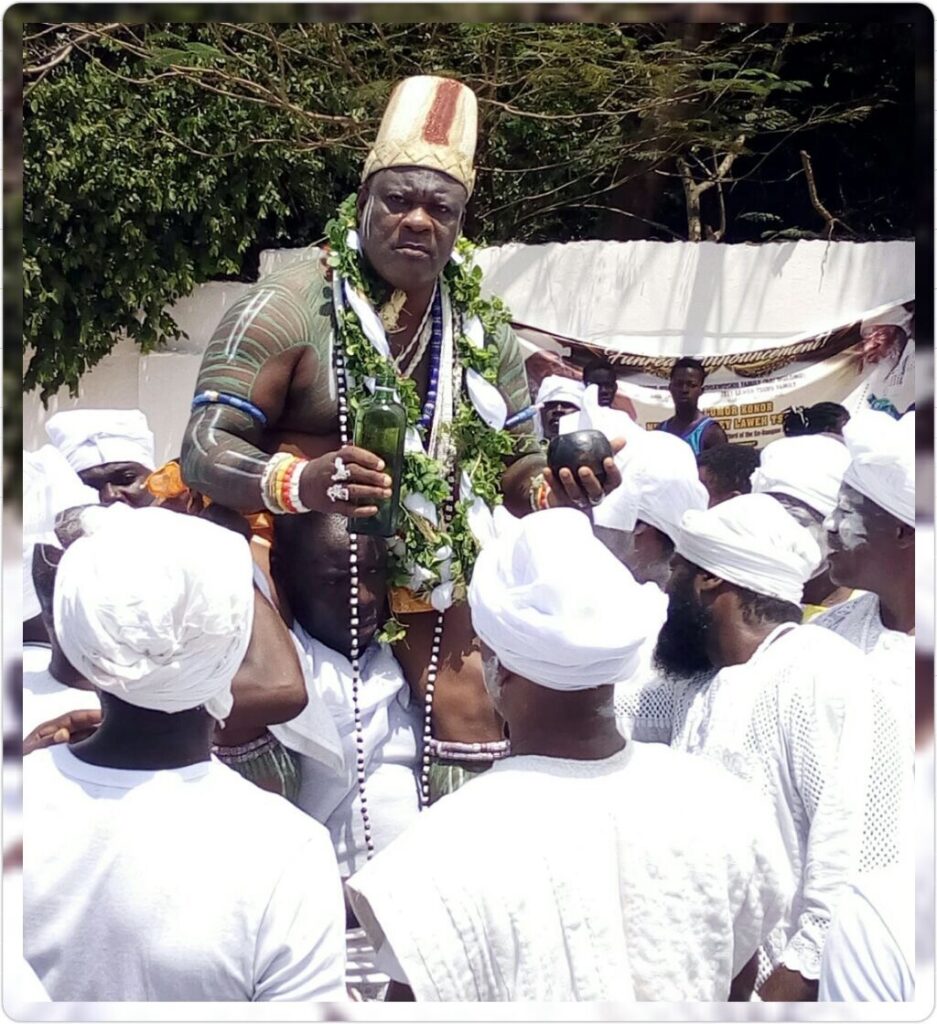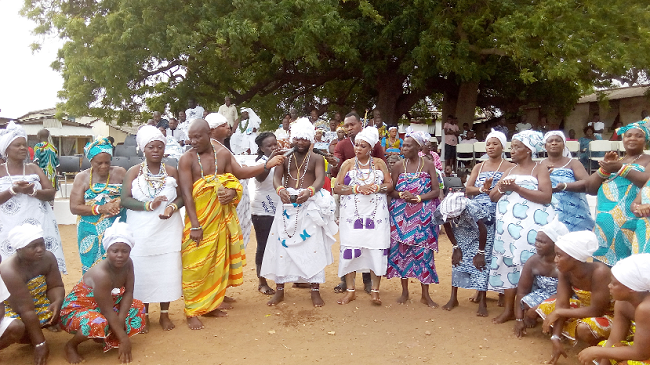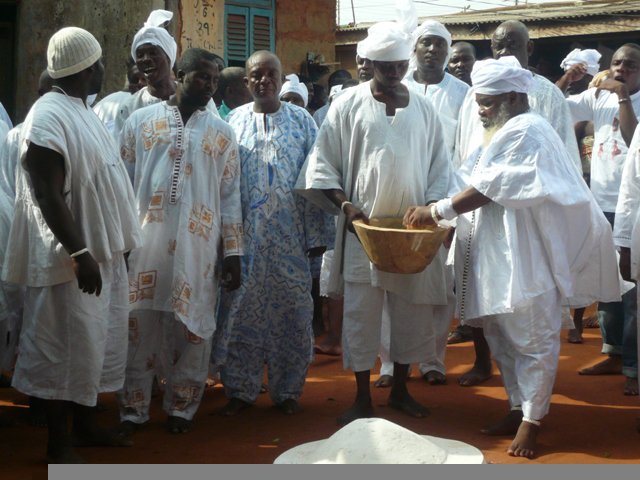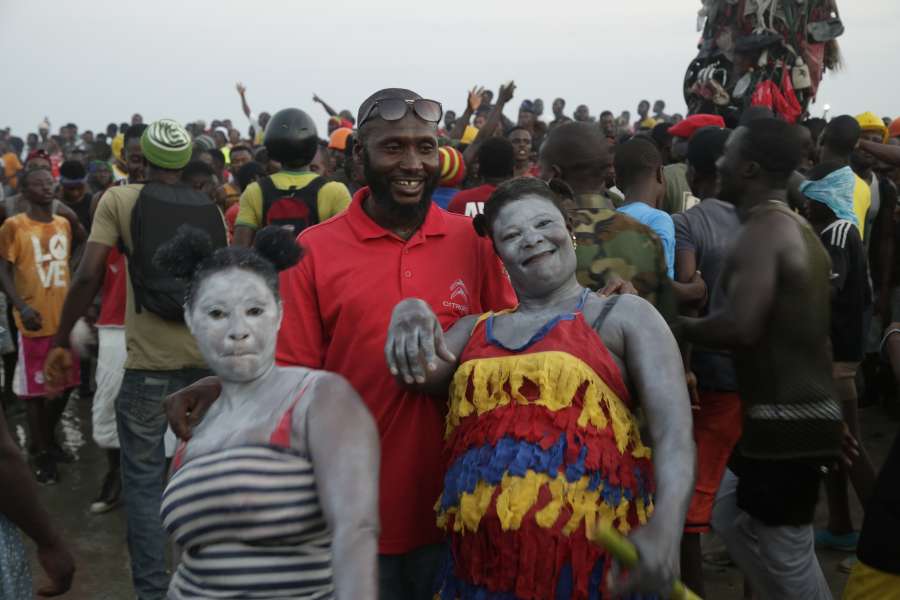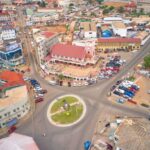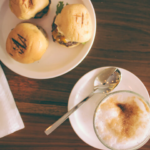Ghanaian festivals are a colourful and vibrant part of the culture. Each year festivals and durbars are held in various parts of the country to celebrate the heritage of the people. Throughout the year festivals and durbars are held in various parts of the country for reunion, development purposes and to strengthen beliefs of society. One of these festivals is the Hͻmͻwͻ Festival celebrated by the custodians of Ghana’s capital city, Accra.
The Hͻmͻwͻ Festival is a harvest festival celebrated by the people of the Ga Traditional Area, in the Greater Accra Region. It originated from a period of great famine which was eventually followed by a bumper harvest in grain and fish. Thus, the word “Hͻmͻwͻ”, literally means “hooting at hunger”. The main highlight of this month-long festival is the special dish prepared from ground corn, steamed and mixed with palm oil and eaten with palm nut soup.
Prayers for a peaceful and prosperous year are offered. Each Ga chief is followed by a retinue with drumming, dancing and singing through his area where he sprinkles some of the special dish called “kpokpoi” and pours libation. It is merry-making for Gas, and visitors, in particular, are invited home to join in the feasting.
The Ga Traditional Area is subdivided into six independent towns Ga Mashie, Osu, La, Teshie, Nungua, and Tema. Each town has a stool, which serves as the central object of Ga ritual and war magic. During the month-long festival, each town celebrates the feast in accordance of the Ga Traditional Calendar.
- GA MASHIE
Ga Mashie is the home of the original Ga settlers. Its located in the central district of Accra along the southern coastal belts of Ghana and headed by a paramount chief who is also the chief and president of Ngleshi Alata Clan, Oblempong Nii Kojo Ababio V. The Ga Mashie Community which has seven clans consisting of Sempe, Otublonhum, Abola, Asere, Akugmaje, Gbese and Ngleshi Alata, is mostly known as the capital of the Ga Traditional Area.
Ga Mashie is the first to begin the celebration. “Lante Djan We” of Asere clan begins within the last weekend of July and the other clans in Ga Mashie continues with their celebration two weeks after, depending on the traditional calendar. During the celebration, there are a number of activities that take place, notable one includes “Yeyeeye“.
Yeyeeye is a ritual performed for twins during the festival, this practice is usually done on Fridays. The twins are dressed uniformly accompanied by some relatives and loved ones singing, chanting and dancing as they parade through the principal streets of James Town.
On the day of the feast which mostly falls on Saturday, the chiefs of various clans sprinkle the traditional food known as “Kpokpoi” in and around their jurisdiction. Later in the day, music concerts and other fun games is been organized by the youth in the community. A grand durbar takes place to climax the entire occasion.
2. OSU
Located about 3 kilometres east of the central business district, Osu is a neighbourhood in central Accra, Ghana, known for its busy commercial, restaurant and nightlife activity, yet it doesn’t take away their love for tradition and customs. Headed by their paramount chief His Majesty DF Nii Okwei Kinka Dowuona VI, the people of Osu are next to celebrate the Hͻmͻwͻ Festival. It mostly takes place seven days after Ga Mashie had finished with their celebrations.
Unlike Ga Mashie, the Osu Hͻmͻwͻ is held on Tuesday and Wednesday. Chiefs of various clans in the community sprinkle Kpokpoi in and around their area thanking the gods and ancestors for their lives and abundant harvest of food.
3. LA
The present-day Guang and Ga-Dangme people who live in Greater Accra are believed to have originated from Benin, Nigeria, having arrived by about the 14th century. The La people are of the Guang branch. Holding on their cultural heritage close to their heart, the Hͻmͻwͻ Festival is one occasion which is significant to the chiefs and people of La. Like the people of Osu, La also celebrates their share of the Hͻmͻwͻ Festival seven days after Osu and it also held on Tuesday and Wednesday. Chiefs of various clans in the community sprinkle Kpokpoi in and around their area thanking the gods and ancestors for their lives and abundant harvest of food.
4. NUNGUA
Nungua was founded by Wor-Kunor Borketey Lawerh. This emperor had seven vassal states under him was known as Wordukom La, (Kpeshie which was his place of abode), Wokplenaa, (thus from Kpone to river Volta), and Woshagba amongst others. According to the new Gborbu Wulomo, there was a hunger for thirst in Worbobor and so Wor-Kunor Borketey dug the ground and got good drinking water without salt so he named the place “nunnma” meaning good drinking water, which was later corrupted to Nungua.
To this end, the celebrations and rites of the Homowo festival are done by the Gborbu Wulomo and not the chief of Nungua. And this starts with the filling of the traditional pot with sacred water. This is known as the “first dudor mli nu woo,” which is done on the first Sunday of the month of May. Nungua people celebrate their Homowo season on the fifth Saturday after that of the Ga Mashie.
During the climax of the season, the sprinkling of traditional customary food known as the kpokpoi is been done by the citizens of Nungua. The first day of ‘Krowor,’ the New Year calendar of the people in Nungua is used for socialisation, reconciliation, and the showering of blessings to mark the New Year.
5. TEMA
The chiefs and people of Tema and its surrounding villages commemorate the annual Homowo festival with drumming, dancing and the performing of traditional rituals that usually come with the sprinkling of Kpokpoi, incantations and pouring of libation. Hundreds of natives of the town, especially those domiciled beyond the Greater Accra Region and abroad, join their relatives and traditional rulers to celebrate the festival in a grand style.
The Paramount Chief of the Tema Traditional area, Nii Osongaa Adjei Kraku II, rides in his palanquin through the principal streets of Tema Manhean, receiving cheers and accolades from his subjects. Also, the sub-chiefs under the Tema Traditional Council, fetish priests and priestesses, other high ranking traditional office holders, and subjects of the area join the Paramount Chief and his elders to perform the rituals.
6. TESHIE
The people of Teshie, a fishing community along the coast of Accra, celebrates their annual Homowo festival on the fifth Saturday after that of the Ga Mashie. The event, which attracted a gargantuan crowd, made up of indigenes and foreigners displayed the rich cultural heritage of the Teshie to the rest of the world. The festival consists of many activities notable one is the “Kpaa Shimo“.
Kpaa Shimo is a local dialect in Ga which is used to describe the street carnival held during the Teshie Hͻmͻwͻ. The event is characterized by the singing of warlike songs composed by the local people. The song is laced with satire and obscenities aimed at exposing some of the ills of the community and the country at large.
The festival official marked the end of the Homowo festival in all the Ga land which comprises Ga Mashie, Osu, La, Teshie, Nungua and Tema. The festival is celebrated to mark the end of famine that plagued the people upon their migration from Israel to their present settlement.


